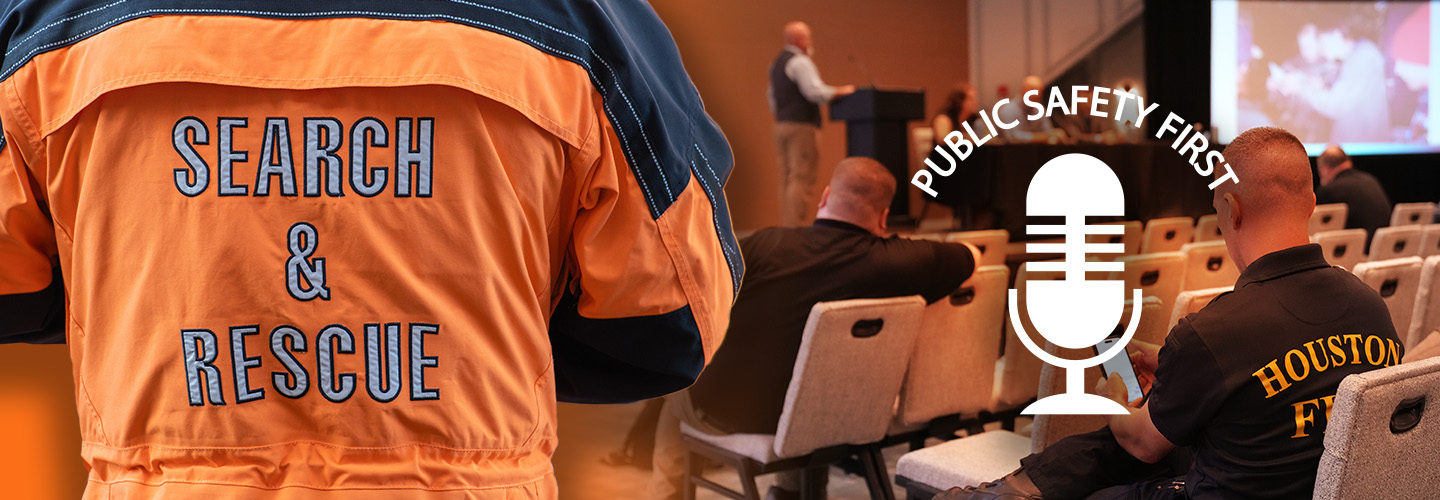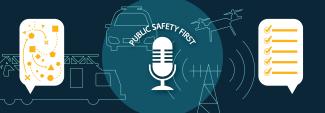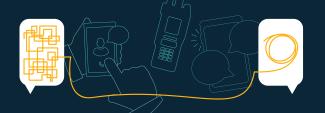Summary
Guest
Travis Hull, FirstNet Authority User Experience Domain Lead
Kate Cummings, Operations Lead and Board Chair, Washington Explorer Search and Rescue, Kitsap County
Ben Lawrence, Wildland Fire Projects Specialist, Colorado Center of Excellence for Advanced Technology Aerial Firefighting
Jason Day, Director of Unmanned Aircraft, Texas Department of Public Safety
Transcript
Preview
Episode 85 | Live at 5x5: Clearing the Air — The Digital Evolution of Search and Rescue
Narrator: You're listening to Public Safety First, a podcast to help you learn about the First Responder Network Authority and how you can be part of the future of public safety technology.
And now, your host.
Episode 85 | Live at 5x5: Clearing the Air — The Digital Evolution of Search and Rescue
Narrator: You're listening to Public Safety First, a podcast to help you learn about the First Responder Network Authority and how you can be part of the future of public safety technology.
And now, your host.
Travis Hull: Welcome to the podcast. I’m Travis Hull, user experience domain lead with the First Responder Network Authority. The episode you are about to hear was recorded Live at 5x5: The Public Safety Innovation Summit in Chicago. I had the opportunity to discuss a topic that I am personally passionate about — search and rescue — and how broadband technologies are enhancing response. I have been involved in search and rescue for over 10 years as a K9 handler, and recently certified as an operations lead.
I was joined by Kate Cummings, operations lead and board chair for the Washington Explorer Search and Rescue team here in Kitsap County; Ben Lawrence, wildland fire projects specialist at the Colorado Center of Excellence for Advanced Technology Aerial Firefighting as well as operations lead for his team in Mason County, Colorado; as well as Jason Day, director of unmanned aircraft for the Texas Department of Public Safety. The panel was introduced by FirstNet Authority board member, Brian Crawford.
It was a great conversation about how technology is changing the landscape of search and rescue missions. I hope you enjoy!
Brian Crawford: My name is Brian Crawford. Come with a fire service background, chief of two metropolitan departments, city manager for another metropolitan city, and then work in health care now. But before that, was a USAR [Urban Search and Rescue] task force commander for Louisiana Task Force 1. And so, search and rescue is near and dear to my heart.
My last search and rescue was an F4 tornado that touched down in Tuscaloosa, Alabama. I think it was 2012, so it's been a while. And so, when we started having conversations with the panel here about what we were going to talk about, I said, we'll talk about what happened between the evolution of broadband and FirstNet, and what's available now in geospatial spatial efforts. You know, drones, miniature robots that are now being able to go in spaces. I mean, I wish I had all that. I had maps, basically, and compasses and LMR [Land Mobile Radio] and that's all I had. So, we're excited about today's conversation because it's really where it's going with search and rescue now and the advent of FirstNet and everything that's available through broadband has really been a game changer for search and rescue.
So, with that, let me introduce our expert panel that we're going to have up here and answering the questions for you and doing the presentations today. So, Travis Hull is with Kitsap County, Washington, canine handler and search and rescue operations lead. Kate Cummings, Kitsap County operations lead, and chair. Ben Lawrence, operations lead in Colorado. Jason Day, director of UAS [unmanned aircraft system] programing in Texas Department of Public Safety. Let's give them all a round of applause before we get started.
Travis Hull: Thank you, Brian. Really appreciate coming along and introducing us. Hi, Travis Hull, FirstNet Authority but also search and rescue for 11 years now. These are volunteers. These are people working on the weekends to help their community. So, it's just amazing to see all that. With that, I think I'll hand it off to Kate — if you want to introduce yourself, talk a little bit about the Explorer Search and Rescue Team, what kind of missions we do. And then you get to talk about the history. Have at it.
Kate Cummings: Yeah. So, I've been in search and rescue now for about 22 years. I actually joined at 14. My unit's kind of what's considered a general kind of ground unit. We do some low angle stuff for safety, but we're kind of a general ground grunt unit, and we're largely wilderness search and rescue based, although we have some urban searches. So, I have been around for a while, so we kind of wanted to give you to start out a quick run through of search and rescue and how it's evolved over the last kind of 20 years.
When we talk about search and rescue technology, one of the constraints is it's volunteer based, which means our units are all donation driven, which means we retrofit, we take second hand, we build a lot of it ourselves. And so, when we talk about technology, we're not ju st talking about maybe what's available, but also what's affordable. And so, a lot of stuff that might have been out there, even that some folks in this room might be aware of, we might not necessarily have had the ability to afford at the time.
So, shortly before I joined, we went to kind of a bread box-type van for our command post. And then just recently in 2019 or so, we transitioned to a trailer, which was much kind of roomier and made for more modern technology. And the initial kind of mapping technology that we had was pretty basic. You could put points on a map, you could put range rings on a map to kind of give you an idea of distance. Not a whole lot else. But that was still pretty kind of epic for the time.
When we talk about technology and search and rescue, there's a couple kind of components or areas that we're looking at. So one, you know, what does the command post use? People in base that are planning the search that are figuring out where people are going. What technology were they using? But then there's also the field component. What are our people taking into the field? And when we talk about the command post, at least in my unit, we were using paper maps, probably up until maybe 2002-2003 time frame.
In the field we were using paper maps, predominantly at least, up until about 3 or 4 years ago. We supplemented with GPSs, but in terms of our primary navigation, we were still relying largely on paper maps.
Of course, in search and rescue we do use compasses. In my unit, we still carry compasses, train with compasses. We had GPSs when I joined, but they were accurate to within about 500 ft and not really great. So, we didn't really use them a lot. But around 2010-11 time frame, we started using GPSs. You couldn't live track with them, but you could track where you had been, which was really super critical.
The first search we really used GPSs extensively on was a four-day search. What this let us do was really identify where there were gaps in coverage. So, you bring the GPS unit back to base, we could plug it into the computer and then upload your tracks. And we realized after looking at all the tracks that there was a gap where we had not searched that was actually relatively close to this gentleman's home. And that's where we ended up finding him, about 50ft from his back door after four days. But it was really, you know, analyzing that GPS coverage that gave us the ability to identify where that gap was.
But what's really been the game changer is a technology. It's been around for about ten years, but it's really become pretty robust in the last kind of 5 or 6. What this lets us do is one, we can kind of switch between different types of maps. So, I can look at satellite images or topographical maps or street maps or whatever. I can also toggle on and off lots of different information. So, this was the first time we had technology that really let us draw assignments onto the maps with any degree of kind of efficiency.
It’s now also on our phones. And so, what I can do I can draw assignments at base. “These are the assignments I want you to do.” And then I can call team one and tell them, “Okay, your next assignment is assignment three.” And they can just look on their phone and see exactly where I want them to go. There's no more confusion about assignments. It makes searches really quiet, which is really weird. There's not a lot of radio chatter. It's really kind of changed how we do things.
It also lets us cram a ton of information in without it really becoming overwhelming. A search that we had as part of a statewide planning unit that I'm also a part of was someone who'd been missing for like five days. And after five days, you've hit your obvious points. And so, you really start getting down to terrain analysis. And so, we just cram a ton of information into a map, and it's not overwhelming. It's digestible. It's easy to toggle things on and off to be able to get different perspectives and that kind of thing. And based on all of that, we were able to really bring all that data together and say, we think he's highly likely to be in this area. That's exactly where he was found alive after five days in the Olympic Mountains.
And then finally, and probably coolest — a search in 2022. This is the first ever search I was on where we used live tracking of teams. That is kind of game changer in search and rescue. On this search, it was the most quiet search I've ever been on, because the people back in base knew exactly where the teams were. Didn't have to say, you know, how are you doing? Where are you at? Didn't have to call for transport because we knew exactly where they were when we needed to pick them up. And it was really cool. And that's kind of become the standard now in the last just few years. It's made our searches way more efficient. It's made our searches way more documented, as an attorney that matters. And so, you know, it's definitely been a game changer just in the last few years with this technology. So.
Travis Hull: All right. So going over to Ben. So same thing — if you want to kind of talk a little bit about your team, which kind of calls you have.
Ben Lawrence: I'm from western Colorado, from a very large county, about 3,400 square miles. 75% of that is public owned land between Forest Service, Bureau of Land Management, other wilderness areas. We service a very large area. We have a team of about 40 volunteers. And we kind of maintain the western tradition, really, of doing search and rescue as volunteers.
I actually I work for an office in Colorado that is heavily into TAK or Team Awareness Kit. A DoD arranged software. As our SAR [search and rescue] team, we've adopted it basically in totality, mostly because it's very good at ingesting lots of information. One of our guys spent an inordinate amount of time, probably five years, making a database of all the trails in the 3,400 square miles of county that we have. So, I wanted to introduce this just as a simple way of our operations leaders being able to know exactly where our folks are on the trail.
We had a horse rollover accident. A lady broke her leg. And, because this is canyon country, the helicopter landed and we had no comms with the helicopter, but because we were using TAK and because we were pumping aircraft feeds into TAK, we were able to see where it landed, and our folks were able to divert off trail and cross country to the helicopter to evacuate the patient. So, it was a very good use of situational awareness to know how folks can deviate from trails to get where they need to be. That's the key thing with TAK is that we know where you're at. We can send people to you.
Another one of the reasons we picked TAK is because it ingests satellite trackers very well in reaches. We have those pumped in. It has points on our maps. We also use some mesh radios. Whenever we go out into the canyons, we're using those. They're small UHF [ultra-high frequency] radios that help us maintain SA [situational awareness] on where our folks are. We used it for an overheated patient. We had a moment where over the radio came, “We're in contact with the patient. He's unresponsive. It's 100 degrees. You see my dot on TAK? Yes. Send me two litter teams, ice, and began cooling the patient,” ultimately saving this guy's life. It's because we're integrating all of the pieces, including broadband, including satellite, including mesh radios, that it's become such a useful tool for us.
Travis Hull: And I want to highlight something. We've all been in the box. “What's your location” “10-T-blahblah” You transpose that number. You gave me too many, read back, right? And it's just back and forth. This — do you see my dot? Cool. You just tell the other teams to converge. They all see the dot because they've got it on their phone. Off you go and save a 79-year-old.
Ben Lawrence: Yeah. And it may seem like a simple thing, but we made sure all colors were different so that you don't even have to ask what trail it is. Go on the yellow trail and you can find me there.
This incident. And again, we're just trying to bring up different ways that that digital technology has changed SAR. The FAA sent us a message saying, “We believe there's an aircraft down in western Colorado, one mile inside of the border.” It's a long drive out there While rescuers are in route, we pulled an ADS-B [Automatic Dependent Surveillance – Broadcast] track. We actually imported that file into TAK, turned it 3D, and estimated where the crash site was going to be. And it was about I think it was about 500 feet off. So, we're using multiple different sources. And again, TAK ingests all of these pieces to help make the searching easier.
The State of Colorado has a multi-mission aircraft. It's used primarily for mapping fires and looking for hot spots out in the wilderness. And one of the really valuable pieces for us is that we're able to see the sensor point of interest, and we're able to keep a track log of where that sensor point of interest, basically where the camera operator has been looking. So, we know if we've covered certain areas better than others. This particular asset has been very useful for us. One particular case, we were using the multi-mission aircraft, we sent them the trail files, all the different colored, and we asked them to search the particular trails. Blue trail. Yellow trail. Pink trail. Out in a big wilderness area for a fellow who'd been missing after a very large snowstorm. And because they were able to focus so clearly on the trails, they actually were able to see his footprints in the snow. They directed us ground searchers into the area where they had fresh footprints, and we were able to make contact and ultimately evacuate him.
Travis Hull: How effective is it for you to actually get that real time awareness versus squinting and looking for pixels and those types of things.
Ben Lawrence: It enables operations leaders to begin planning what's next, because they can see where their people are in their search assignment or where they are in the critical situation, they're able to begin anticipating needs of the searchers or rescuers, in whatever particular case that may be.
Travis Hull: All right. I'm going to call out Jason Day. You can't talk about drones in any public safety kind of operation of Jason's name doesn't come up. They do some amazing work. So.
Jason Day: I'm supposed to talk about drones? Okay. Good afternoon everybody. My name is Jason Day. I wear three different hats for the state of Texas. My primary job is I'm director of unmanned aircraft for the department. We have the largest public safety UAS program in the country. Right now, we sit at about 350 aircraft, about 320 pilots. And really, what our secret sauce is our operational tempo. We conducted about 52,000 drone flights last year. So, that was about a thousand drone flights a week in the state of Texas. Just our department. So, we've learned a lot from that.
I'm going to come to this conversation from a different perspective and really talk about how we use technology to enhance safety of aviation assets during search and rescue operations. Because that's really what our UAS program and our manned aviation program is all about is safety of the national airspace system. We identified this gap from Hurricane Harvey many years ago that we had all these helicopters and airplanes out there flying at low altitudes, and there were hundreds of drone flights taking place, and we did not even know this. So, we wanted to overcome that risk that happens in those kind of situations.
One of my other hats is I sit in the air operations center during a disaster response, like a hurricane, for the state of Texas. And I manage UAS operations from a strategic level. And so, that's really what we're going to talk about here. We conduct an annual event called SAREX, Search and Rescue Exercise. And this is where we practice all the things that we talk about throughout the year. How do we have this interoperability between helicopters and airplanes and now bringing drones into it? Right. Because it took a huge culture shift because our manned aviators, they were like, “No way are we having drones during search and rescue operations.” And then a couple years later, they're like, “okay, you can fly drones”. We brought some teams, but they put us in a separate room. And they're like, “okay, you guys go do your drone thing. We're going to do our manned aviation thing.” But then they're like, peeking over and they can see that we’re live streaming the search and rescue operations in real time.
And they're like, “Is that live? We've never had that perspective in the command center.” Right. And so, they're like, “Hey, why don't we bring all of your stuff into this big room and share all the information.” To the point where now, this year, during SAREX 2024, we had just as many drones as we had helicopters during the operation. And we've continued to expand those capabilities that we provide.
So, the first thing we identified is how do we get pretty close to the helicopter to provide this real time video, back to both the helicopter crew and the emergency operations center, but do it safely where nobody is going to run into each other? And so, power lines, right. That's a man-made obstruction that we use to deconflict the airspace between the helicopter and the drone. We know that they can operate then at the same altitude in pretty close proximity, because that helicopter is going to hit those power lines before it hits that drone. So, that was kind of a really good eye opener for everybody. At the same time, our drone teams are establishing communications back and forth with the helicopter. So, everybody is really talking.
You have to have really good technology that is reliable so that you can conduct complex operations between drones and manned aviation, because the only way to do this safely is to have positive comms at all times. This is going back to the capabilities that the drone provides. So, picture in real time can not only be shared with decision makers sitting in a room, but the guys in the helicopter or the airplane. Right. So, your pilot who cannot see below the helicopter, can now have a second screen in there and see everything that's going on.
There's a lot of times during large scale search and rescue that you get a call. Helicopter crews dispatch. By the time they get there, the victims aren't there anymore. Right. So, let's send the drones out there, see if the victims are there. Get eyes on. Get that Intel, push it to the crews. And if those people are not there, then that helicopter can go save people who actually need saving in the moment.
Travis Hull: Thank you very much for coming. Thank you to the panel. Greatly appreciate it. It's really neat to see the technology that's out there for the SAR teams. Learn how FirstNet can enable it in both the remote, local environments and everything that's being done. So, thank you all for your time. Thanks for coming.
Narrator: Thanks for listening today. We're excited to have you join our podcast community. Make sure to subscribe on iTunes, SoundCloud, and YouTube. You can learn more about the First Responder Network Authority at FirstNet.gov and learn about FirstNet products and services at FirstNet.com.





















